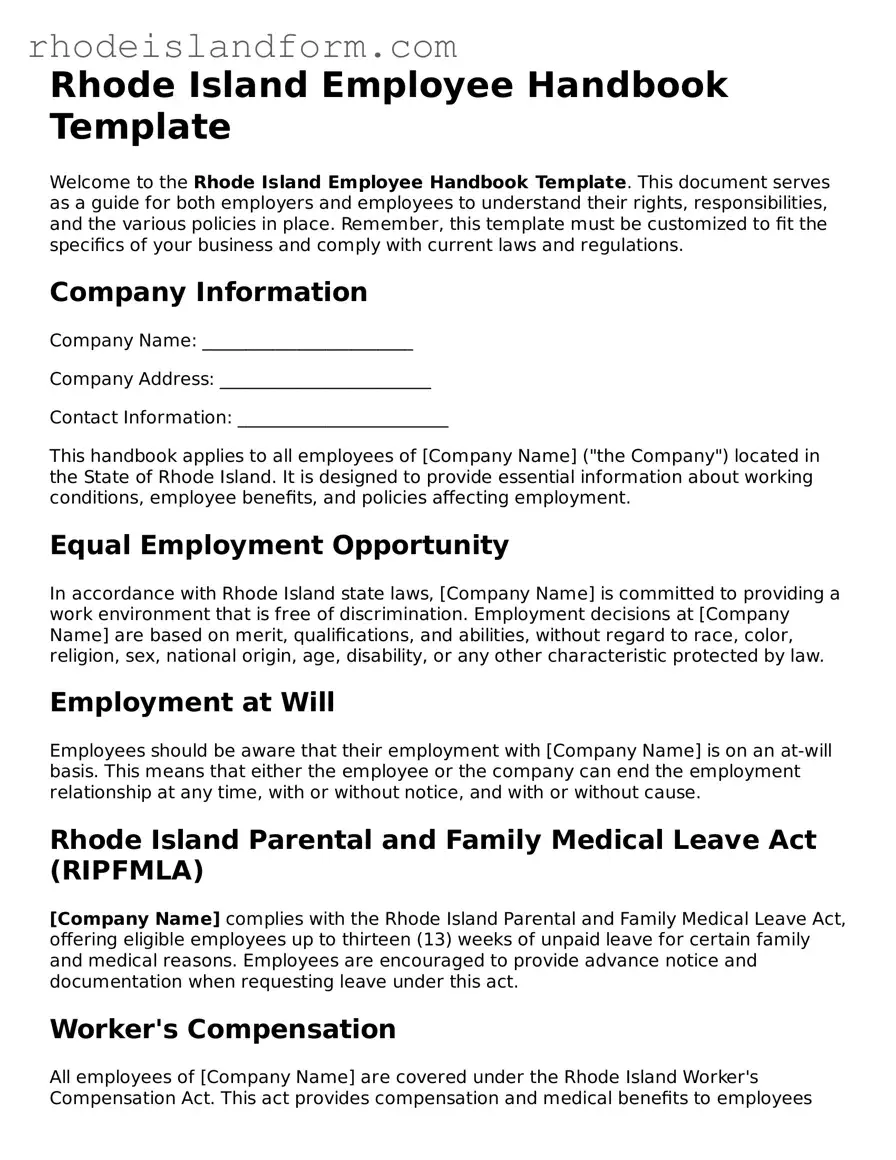Rhode Island Employee Handbook Template
Welcome to the Rhode Island Employee Handbook Template. This document serves as a guide for both employers and employees to understand their rights, responsibilities, and the various policies in place. Remember, this template must be customized to fit the specifics of your business and comply with current laws and regulations.
Company Information
Company Name: ________________________
Company Address: ________________________
Contact Information: ________________________
This handbook applies to all employees of [Company Name] ("the Company") located in the State of Rhode Island. It is designed to provide essential information about working conditions, employee benefits, and policies affecting employment.
Equal Employment Opportunity
In accordance with Rhode Island state laws, [Company Name] is committed to providing a work environment that is free of discrimination. Employment decisions at [Company Name] are based on merit, qualifications, and abilities, without regard to race, color, religion, sex, national origin, age, disability, or any other characteristic protected by law.
Employment at Will
Employees should be aware that their employment with [Company Name] is on an at-will basis. This means that either the employee or the company can end the employment relationship at any time, with or without notice, and with or without cause.
Rhode Island Parental and Family Medical Leave Act (RIPFMLA)
[Company Name] complies with the Rhode Island Parental and Family Medical Leave Act, offering eligible employees up to thirteen (13) weeks of unpaid leave for certain family and medical reasons. Employees are encouraged to provide advance notice and documentation when requesting leave under this act.
Worker's Compensation
All employees of [Company Name] are covered under the Rhode Island Worker's Compensation Act. This act provides compensation and medical benefits to employees who are injured or who contract an occupational disease on the job. In the unfortunate event of such circumstances, employees should report the injury to their supervisor immediately to ensure proper documentation and care.
Harassment and Discrimination Policy
[Company Name] strictly prohibits harassment and discrimination in the workplace. The company has established procedures for reporting and resolving complaints of discrimination, harassment, and retaliation in accordance with Rhode Island laws. Employees are encouraged to report any instances or concerns without fear of retaliation.
Drug-Free Workplace
[Company Name] is committed to providing a safe, productive, and drug-free work environment. In keeping with this commitment, employees may be required to undergo drug testing in compliance with Rhode Island laws and company policies.
Technology Use Policy
Employees of [Company Name] are expected to use company-provided technology resources responsibly and ethically. The company reserves the right to monitor all electronic communications and technology usage to ensure compliance with this policy and applicable laws.
Attendance and Punctuality
[Company Name] expects employees to be reliable and punctual in reporting for scheduled work. Excessive absenteeism or tardiness can lead to disciplinary action, up to and including termination of employment.
Confidentiality Agreement
As a condition of employment, employees are required to sign and abide by a confidentiality agreement which protects the proprietary and confidential information of [Company Name] and its clients.
Disciplinary Action
[Company Name] has established a system of disciplinary action that may be taken for violations of company policies and procedures. This may include verbal warnings, written warnings, suspension, and termination, depending on the severity of the offense.
Acknowledgement of Receipt
All employees are required to acknowledge that they have received, read, and understand the [Company Name] Employee Handbook and agree to abide by its terms during their employment with the company.
This document is intended as a summary of [Company Name]'s policies and procedures and is not intended to create contractual obligations. [Company Name] reserves the right to amend or revoke any policies or provisions in this handbook at any time without notice.
